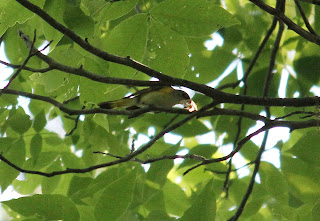The Spring of 2012 was my first as a "birder". My new birding friends had been saying in months previous that I was going to love the fall warbler migration on the East Coast. If I could do my spring birding over again I would have taken some time off work during the second weekend of May to really hit the birding hard. I went out a lot before and after the second week in May and I was able to see a lot of these magnificent little creatures.
The third weekend in May I was at "The Ramble" in Central Park. It was a great experience to see so many regular birders and I was able to make some new contacts. I was told that had I been there a week earlier I would have seen at least 20 species of warblers in a "fall out". I guess when they are migrating North they will at times just "fall out" of the sky and rest in trees or on the ground. They then go on feeding frenzies in the locals where they fall out and regenerate for the continuation of their migration.
Most of the following birds depicted are current residents and/or nesting. Some of the others were just caught on a feeding break from their migration North.
Female Black-and-white
Allendale Celery Farm, Bergen County, NJ
Male Blackburnian
Stokes State Forest, Sussex County, NJ
Female Blackburnian
Stokes State Forest, Sussex County, NJ
Male Black-throated Green
Stokes State Forest, Sussex County, NJ
Female Black-throated Blue
The Ramble, Central Park, New York County, NY
Male Blue-winged
Doodletown, Rockland County, NY
Male Chestnut-sided
Allendale Celery Farm, Bergen County, NJ
Male Common Yellowthroat
Teaneck Creek Conservancy, Bergen County, NJ
Male Common Yellowthroat
The Ramble, Central Park, New York County, NY
Male Hooded
Stokes State Forest, Sussex County, NJ
Male Magnolia
The Ramble, Central Park, New York County, NY
Ovenbird (sexes similar)
Stokes State Forest, Sussex County, NJ
Male Northern Parula
Stokes State Forest, Sussex County, NJ
Palm (sexes similar)
1st - Jamaica Bay National Wildlife Refuge, Queens County, NY
2nd - Richard W. Dekorte Park, Bergen County, NJ
3rd/4th - Allendale Celery Farm, Bergen County, NJ
Male American Redstart
Teaneck Creek Conservancy, Bergen County, NJ
Female American Redstart
Sterling State Forest, Orange County, NY
Pair of Yellows
Teaneck Creek Conservancy, Bergen County, NJ
Female Yellow
Indian Pond, Bergen County, NJ
Male Yellow
Teaneck Creek Conservancy, Bergen County, NJ
Male Yellow
Saddle River County Park, Bergen County, NJ
Male Yellow-rumped
Jamaica Bay National Wildlife Refuge, Queens County, NY
Male Yellow-rumped
Richard W. Dekorte Park, Bergen County, NJ
Female Yellow-rumped
Allendale Celery Farm, Bergen County, NJ
Female Nashville?
Allendale Celery Farm, Bergen County, NJ
My most memorable birding experience thus
far was at Stokes State Forest. It was a trip organized by the 2012
Sussex County Birding and Nature Festival. Led by Sharon Ann Wander,
Ph.D. and her husband Wade Wander, M.Sc., the event was called "Warblermania",
hence where I got the name for this post. We saw or heard over a dozen
species. I will likely make a future post concerning this trip. We saw
nearly 50 species in about five hours.
Sharon did her Ph.D. on Ovenbird breeding biology in large versus fragmented forests. This couple exclusively bird by ear and knew every bird by their calls, songs, sounds, etc. Sharon called in several warbler males, Veerys and even a Brown Creeper with an application on her iPod attached to a small handheld speaker. The Wanders mentioned that warbler numbers have plummeted slowly over the last few decades. They told us warblers and other neotropical migrant species do not come back in the kinds of numbers they used to. Wade said there were two theories as to why this is happening. One is the destruction of their habitat over the entirety of their migratory range. The other is the use of chemicals like herbicides and pesticides in their wintering grounds in Central America, South America and the Caribbean Islands. These chemicals are banned in the U.S., however, the manufacturers that used to make and sell them to U.S. companies now sell them to countries in the Caribbean and Central and South America. Warbler declination is probably a mixture of both of the aforementioned theories. Their future in most definitely uncertain if people cannot find ways to prevent their numbers from declining.



















































No comments:
Post a Comment